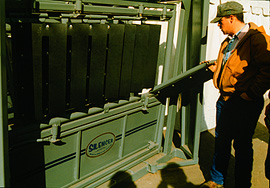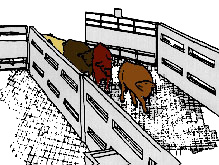The Principles Of Low Stress Restraint Cattle and Pigs
(Updated August 2017)
 |
Cattle restraining squeeze chute with angled rubber louvres on the side which prevent the cattle from seeing people. The side can be opened for easy access for injections and other veterinary procedures. The louvres block the animal's vision the same way that louvred shutters block vision through windows in a house. |
- Solid sides or barriers around the cattle to prevent them from seeing people deep inside their flight zones. This is especially important for wild or excitable cattle.
- To prevent lunging at the headgate, the bovine's view of an escape pathway must be blocked until it is fully restrained. This principle does not apply to pigs.
- Provide non-slip flooring for all species of animals.
 |
A good example of a non-slick surface for livestock. |
- Slow steady motion of a restraint device is calming, while sudden jerky motion excite.
- Use the concept of optimal pressure. Sufficient pressure must be applied to provide the feeling of restraint, but excessive pressure that causes pain or discomfort must be avoided.
- The entrance of the restraint device must be well lighted, however, lamps must not glare into the eyes of approaching animals. All species must be able to see a place to go.
- Livestock will remain calmer if they can see other animals within touching distance.
- Engineer equipment to minimize noise. High pitched noise is more disturbing to livestock than a low pitched rumble.
- Restraint devices must be designed to avoid uncomfortable pressure points on the animal's body. If an animal vocalizes (moo, bellow, or squeal) when a restraint device is applied, it may be applying excessive pressure or pinching the animal.
- Restrain livestock in an upright position.
To keep welfare standards high requires continuous measurement of performance to prevent old rough practice from returning. Handling quality should be continuously monitored by using the following outcome measurements. This will make it possible to determine if practices are improving or becoming worse. The following outcome based measure should beused in both farms and slugher plants.
- Percentage of animals falling during handling. Should be 1% or less. Includes: truck loading, unloading, sorting, and movement into veterinary hospital.
- Percentage of animals slipping handling.
- Percentage of cattle or pigs vocalizing (moo-bellow or squeal) during restraint. An excellent score is 5% or less.
- Percentage of animal moved with an electric prod. Goal 5% or less.
- No Acts of Abuse, such as beating, hard tail twisting, dragging or slamming gates on animals.
References
Grandin, T. (2016). Evaluation of the welfare of cattel housed in outdoor feedlot pens. Veterinary and Animal Science. 1-2:25-28.
Grandin, T. (2013). Making slaugher houses more humane for cattle, pigs, and sheep. Anual Review of Animal Biosciences. 1:491-512. Posted on this website: www.grandin.com
Grandin, T. (2012). Developing measures to audit welfare of cattle and pigs at slaughter. Animal Welfare. 21:351-356.
Grandin, T.(1995). Restraint of Livestock Proceedings : Animal Behaviour, Design of Livestock and Poultry Systems International Conference pages 208-223. Published by: Northeast Regional Agriculture Engineering Service, Cooperative Extension. 152 Riley - Robb Hall Ithaca, New York, 14853 USA.
Grandin, T. (Editor). 2014. Livestock Handling and Transport, 4th Edition CAB International Wallingford Oxon, United Kingdom.
Grandin, T. (1991). Double Rail Restrainer For Handling Beef Cattle. Paper No. 915004 American Society of Agricultural Engineers. 2950 Niles Road St.Joseph, Michigan, 49085 USA.
Grandin, T. (1998). Double Rail Restrainer For Livestock Handling. Journal of Agricultural Engineering. Research. 41:327-338
Welfare Quality Network (2009). Acces by typing welfare quality network into Google.
Woiwode, R. et al. (2016) Compliance of large feedyards in the northern high plains with Beef Quality Assurance Feedyard Assessment. Professional Animal Scientists. 32:750-757.
 Click here to return to the Homepage for more information on animal behavior, welfare, and care.
Click here to return to the Homepage for more information on animal behavior, welfare, and care.


